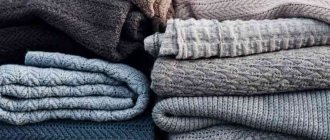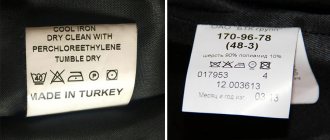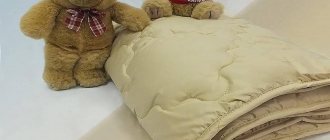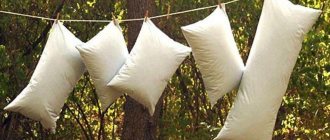Features of wool products
There are several types of wool fibers and fabrics, which differ in the method of manufacture, origin, and the presence of synthetic impurities:
- Angora is a wool fabric made from goat or rabbit fluff. It is very pleasant to the body and is light and has low density.
- Camel wool is a 100% natural, environmentally friendly product. Its main properties are antibacterial, antistatic, light, hypoallergenic.
- Cashmere is a wool or wool blend fabric made from the down of cashmere mountain goats, synonymous with airiness, softness, and a symbol of prosperity.
- Sheep wool is a common type, known for its medicinal properties, and is considered one of the warmest.
- Merino – obtained from the wool of “fine-wool” Merino sheep. The yarn is smooth, silky, flexible, thermally insulating, and can also repel odors.
- Mohair is a fabric that partly consists of angora (about 80%), the remaining 20% is synthetic fibers. Mohair is less susceptible to deformation, is hypoallergenic and very durable.
Depending on the type, the properties and, consequently, the care requirements change. However, all types consist entirely or partially of natural hair, which, like human hair, is covered with tiny scales. Under the influence of water, temperatures and cleaning agents, these scales open, which makes the wool especially vulnerable. Left without protection, the pile sticks together, becomes compacted, deformed, and loses its airiness and softness. Therefore, it is important to carry out the process of washing a sweater, socks, hat or trousers made of wool as carefully as possible.
Washing rules
Some people prefer to buy synthetic clothing because natural wool is quite difficult to care for.
There are several rules that will help you wash woolen items correctly:
- It is better to clean them as rarely as possible, because frequent exposure to detergents harms the fibers.
- Before washing, be sure to examine the sew-in tag. It indicates information about the acceptable mode, washing and ironing temperature.
- Some items can only be washed by hand, this is also stated in the instructions.
- To reduce damage to the product, it is better not to wash it, but to get rid of unpleasant odors by airing it in the fresh air.
- It is advisable to clean heavy stains before washing using a dry method.
How to wash a wool coat
Needless to say, before washing a wool coat, you should study the label on it. Today, in addition to wool, other raw materials are used to make such products.
Please note that the more wool there is in the fabric, the less chance you have of maintaining the shape of your favorite coat using an automatic machine.
Do not neglect the basic principles of how to wash a coat made of wool:
- Temperature up to 30°C;
- Turn off spin;
- Use only those cleaners that are intended for woolen products;
- Program the device for “Hand Wash”.
What can't you do?
Since woolen fabrics are delicate, there are precautions that will help protect them from damage. Here are some recommendations common to all clothing of this type:
- Wool does not tolerate hot water, boiling is also prohibited. In addition, you should not allow sudden changes in temperature during the washing process.
- It is not recommended to soak the material for a long time; the maximum allowable time is 30 minutes.
- You cannot twist, squeeze, stretch, or actively rinse the wool, since under the influence of external force it deforms very quickly.
- The spin speed in the washing machine should be set to the minimum.
- Washing with aggressive detergents is prohibited; low-quality powders and gels should also not be used.
- You cannot pour dry powder directly onto woolen fabric; before use, it must be dissolved in a large amount of water and whipped into foam.
- You cannot dry wool items hanging, that is, on ropes or hangers. Since the fabric does not tolerate high temperatures, it is not worth drying it on a radiator, with a hairdryer or other thermal influences.
- Whether ironing is allowed or not can be found out from the instructions on the label. Some types are tolerant of hot steam, while others may lose their shape and softness.
Water temperature
Wool should be washed at a temperature not exceeding 40°C; washing at 30°C is optimal. If you use hot water, the product loses strength, as a result of which it can shrink, become hard and unpleasant to the touch. Raising the temperature to 60-70°C is permissible only if you need to make a sweater a couple of sizes smaller, but you should do this as carefully as possible.
Detergents
Conventional washing powders are not suitable for materials made from natural wool fibers. It is recommended to use special ones for wool and silk, which prevent caking and do not destroy the structure. However, washing gels marked “For delicate fabrics” are considered more effective and gentle. They promote high-quality removal of contaminants and are washed out better without leaving streaks.
Unfortunately, no powder or gel will help maintain the softness of wool if the water in which the wash is carried out has an increased level of hardness. You can find out by observing how the liquid from the tap behaves when boiling. If scale remains on the walls of a saucepan or kettle, the water hardness is increased. In this case, it is recommended to use softeners and conditioners for washing, which will give clothes softness and freshness. For the same purpose, you can take a 9% vinegar solution. Acid is also suitable for preserving color: pour it into the conditioner compartment if the item needs to be washed in a washing machine, or use it when washing by hand.
Attention! If you urgently need to remove a stain, but you don’t have a suitable product at hand, you can use shampoo. It has a more gentle effect than conventional products.
Procedure
Woolen items should be washed in the correct order, strictly following the following procedure:
- Preparing for washing. Fasten all the buttons and clasps, if any, remove everything from the pockets, and turn the sweater inside out.
- Removing dirt with a brush. You can clean the wool with a small amount of glycerin heated in a water bath. It is worth considering that the bristle of the brush should be very soft and the friction very weak. Hydrogen peroxide, which should be moistened with a cotton pad, also removes stains well.
- Soak. This step is necessary if the dry method did not help, there are strong stains left that may not be washed off. You should not soak things for a long time, as staying in water destroys the structure of the fibers. You can leave them in the detergent solution for a maximum of an hour.
- Wash by hand or using an automatic machine. In the first case, it is easier to control the degree of damage, while the second method requires less time and effort. It is important to wash no more than 40-45 minutes.
- Drying. On a horizontal surface at room temperature.
- Ironing. According to the directions on the product label.
At what temperature and how to wash wool?
This action is possible when there is no “hand wash only” marking.
Mostly items made from camel hair are washed in the washing machine. On the eve of washing, they are soaked for 20 minutes in liquid with the addition of a small amount of powder. Then rinse and load into the washing machine. The temperature is set to about 30 degrees. How to properly wash fabrics based on sheep's wool? Before the washing machine starts, turn out the items. Fill the tray with mild detergent plus conditioner. Then select the “no spin” and “wool” programs. Do not forget that the temperature is set no higher than 30 degrees.
Automatic washing requires compliance with certain factors, which relate to:
- processing conditions;
- choice of detergents.
The sweater must first be inspected and any defects (stains, torn seams, etc.) eliminated. In addition, you should prepare a mesh bag, without which the product cannot be placed in the drum.
Washing process:
Turn the item inside out and place it in a laundry bag.- Place the item in the drum of the machine.
- Pour a portion of washing gel into a special container.
- Select the “wool” or “delicate” mode.
- Set the water heating temperature recommended by the manufacturer or 30ºС if there is no label.
- Turn off drying and spinning. If there are no prohibitions on the label, you can set the minimum spin - 400-500 rpm.
- After finishing washing, it is advisable to wring out the product a little. To do this, place it in a terry towel and wring it out without any effort.
The porous structure of wool tends to be difficult to rinse out from detergent, so choosing it must be taken seriously. Powdered preparations are not only less soluble in water, but also less easily washed out of the fibers.
It is recommended to use liquid detergents designed for woolen items.
Wool should be washed in water with a temperature between 30... 350C. And for rinsing, you should use water at the same temperature or a little cooler. If it is not possible to measure the indicator, then the liquid can be checked by hand. It should feel slightly less than body temperature.
A sudden change in liquid level during washing can cause clothes to shrink, become tight and unpleasant to the touch. Therefore, it is recommended to avoid the option of washing in warm water and rinsing in ice cold water.
So how to find a common language with woolen products? The first thing that any owner of such clothing thinks about is how to keep the shape of your favorite sweater after washing? What should I do to prevent the product from shrinking, stretching, or matting? In fact, you can do a lot of things. But all these rules are quite simple and easy to follow.
Paradoxically, it is better not to wash wool. Or rather, do this as rarely as possible - only when necessary to remove specific dirt or stains. In other cases, it is recommended to hang the item of clothing periodically (2-3 times a year) on the street or balcony for ventilation. Streams of fresh air are often enough to refresh the product and get rid of foreign odors.
But if washing is inevitable, you need to prepare for it first theoretically: learn a lot of subtleties. There are three main and most important ones that have the greatest impact on the shape of washed products:
- temperature and its invariability;
- drum speed for machine washing (friction and spin for hand washing);
- proper drying.
So, temperature. For demanding wool, it should not exceed 30-35 degrees, otherwise the product will inevitably shrink or stretch. But for high-quality washing of woolen items, following this rule alone is not enough. It is equally important that soaking, washing and rinsing take place at the same temperature.
Yes, the value of 10 degrees does not exceed 35. But if you wash the item with warm water and then rinse it with cool water, the shrinkage will be much more obvious. Sometimes it’s not even shrinkage, but local deformation (only of the cuffs or just the armpits), and after this it can be problematic to restore the shape of the products.
Mechanical impact (friction, spin) is another primary evil for woolen products. At the same time, they risk not only sitting down or stretching, but also significantly matting or becoming covered in pellets. So no spinning when washing woolen clothes! A minimum of rubbing and washing, a minimum value of the drum speed of the machine - these are important subtleties on the way to the longevity of knitted items.
Such clothes also need to be dried properly. Errors during drying, the main one of which is line drying, also lead to deformation of knitted items, which stretch under their own weight.
If you don’t have time to wash by hand, you can do it in an automatic machine. But you need to look at the label to see if this option is allowed for a particular type of clothing. Before you load things into the drum, you need to:
- remove all accessories (clasps, buttons) to prevent damage;
- sew up the loops so that they do not stretch;
- turn a thing inside out;
- separate from other fabrics, divide into dark and light shades;
- When washing multi-colored clothes in one go, be sure to check them for color fastness.
Modern machines have a “wool” program, usually it is already configured in all respects, but if it is not there, you can use the “delicate” mode, but disabling the spin cycle. It is advisable to add a product without synthetic additives in liquid form or a fine-grained, highly soluble powder. After the end of the program, the items are carefully pulled out and excess moisture is removed from them.
Features of washing in a washing machine
If you don’t have the time or opportunity to hand wash, for example, a wool blanket or sweater, a washing machine will help.
Before the washing procedure, you must do the following:
- Check pockets for forgotten small items: coins, pins, etc. They can ruin both clothes and equipment.
- Remove all removable accessories and cover non-removable ones with nail polish - this way the possibility of rust or other damage is minimized.
Nowadays, most models of equipment have a “For delicate items” mode, which helps to remove dirt as gently as possible: the drum makes the least number of revolutions, practically without damaging the sweater.
In the absence of these modes, wool should be washed in a washing machine using “Quick 30°” or “Hand Wash”, spin – minimum number of revolutions. It is better to add an additional rinse.
Why does wool shrink and fall off?
As you understand, wool is a completely natural, living material. And the structure of the wool fiber consists of scales that fit together very loosely; they are literally permeated with air.
And it is precisely thanks to this structure that wool warms so well. After all, there is nothing warmer than an air cushion!
But, due to exposure to unnatural temperatures, the wool scales shrink, adhere to each other, the air leaves them and from this the once airy fiber literally turns into a lump.
Therefore, it is so important to know how to properly clean such products.
And then, the natural structure will not be violated. See also:
Dyeing jeans in the washing machine
Proper drying
Since it is prohibited to dry products in a vertical position, it is necessary to place them on a horizontal surface, for example, on a table. Under a woolen item you need to place a fabric that absorbs moisture well, a terry towel will do. Products must be turned over every half hour to hour so that they dry evenly. Of course, this method requires some effort, but it will help maintain shape. Drying can be done outdoors, but it is better to avoid direct sunlight.
How does wool behave when washed?
Washing woolen products is a labor-intensive and somewhat risky process, since wool is a delicate material and requires special attention. Under unfavorable conditions, woolen fabric can become deformed, shrink and stretch.
Woolen items require special care, so fans of clothing made from this natural material should know what not to do with them. So, they don’t like wool products:
- high temperatures and their changes;
- aggressive influences, such as creases and friction;
- direct sunlight;
- powder detergents.
By the way, wool “does not like” wet cleaning, so try to wash such clothes as rarely as possible. To refresh your favorite sweater, sometimes it is enough to air it well, and local dirt can be cleaned with a solution of vinegar or hydrogen peroxide without exposing the entire fabric to moisture.
How to bleach a woolen item?
Everything white eventually becomes dull, yellowish or grayish. However, if the whiteness of ordinary picky material is restored using boiling and soaking with bleach, then such methods are not suitable for delicate ones.
Here are a few methods to help whiten wool:
- Baking soda and ammonia work well with old yellowness. 1 tbsp. l. It is necessary to dilute it in 5 liters of cool water, add 2-3 drops of ammonia, soak the product in the resulting liquid for 30 minutes, wash it in an automatic machine or by hand.
- Hydrogen peroxide will help bleach white woolen items. It needs to be added to water (1:8), then soak the clothes in this solution for an hour.
- Dissolve about 500 g of salt in 5 liters of water, leave the wool for half an hour, then wash with conditioner.
Proper washing of woolen items: 4 steps
Cleaning wool occurs in several stages. They have their own characteristics that should be taken into account. All details are important, because... Any disregard of the rules may cause deformation of the product.
Step 1. Preparation
Before washing, you need to sort light and dark clothes, and also study the manufacturer’s care recommendations, which are indicated on the label.
If there are significant traces of dirt, you must first clean them with a soft bristle brush. Then unplug or remove any hardware that may cause snags or leave rust stains during the cleaning process.
The last preparatory stage is checking for color fastness. You need to dip one thread from the product into a hot soapy solution, and then wring it out in cotton fabric. If it is colored, you should add vinegar when washing.
Step 2. Washing
Washing woolen items is carried out manually or in an automatic machine. This material does not need pre-soaking if there is no persistent contamination. The duration of the entire procedure should not exceed 45 minutes, because... prolonged contact with moisture increases the likelihood of product deformation.
Read more ► How to wash a cap so that it doesn’t lose its shape: by hand and by machine, what products to use
Algorithm of actions for manual cleaning.
- Fill a basin with water at a temperature of 30 degrees.
- Dilute the washing gel or powder until completely dissolved.
- Turn the clothes inside out and soak for 10-15 minutes.
- Wrinkle it slightly, because... strong impact causes deformation.
Washing in an automatic machine is recommended on a delicate cycle. This means that the water temperature is no higher than 30 degrees and the spin speed is 500. At the end of the process, you need to install an additional rinse.
Step 3: Rinse
This stage plays an important role, because Detergent residue negatively affects the appearance of clothes and significantly reduces their service life.
Basic rules for rinsing.
- Carry out the procedure several times, first in warm water, and then in cool water.
- When rinsing, use special softening agents to prevent the hair from itching or matting.
- To prevent the material from fading, it is recommended to add vinegar when rinsing in a proportion of 1 tablespoon per 1.5 liters of liquid.
Step 4. Spin
It is not recommended to twist the wool, and excess moisture should be removed with a terry towel.
The procedure is carried out as follows.
- Spread the towel on a flat surface.
- Lay the sweater on top, having previously leveled it.
- Wrap it in a roll.
- Squeeze lightly.
Tips for care and use
It is very important to properly care for woolen items so that they last as long as possible. Here are some recommendations:
- A woolen item that has shrunk after washing should be slightly wetted, ironed through gauze at a low temperature, smoothing it, and given the desired shape.
- You should not try to pull out the pills from a sweater with your hands, much less cut them off with scissors. There are scallops and electric machines for this.
- You should not overuse dry cleaning, even if dirt can only be removed with its help. The substances used in the cleaning process gradually corrode and thin the fibers.
- The ties can be removed using a crochet hook: with the tool you need to pick up the loop that has come out from the inside and carefully pull it back.
- Woolen clothes should be stored on a shelf or in a drawer; they may become deformed on hangers.
- Moisture is the enemy of wool, so you need to avoid damp areas when choosing a storage location.
Wool shrinkage
All of the above recommendations help maintain the original appearance of the product. But sometimes you need to wash an item - for example, a wool sweater - so that it shrinks. For this, the following technology is used:
- Dip the sweater in soapy water heated to 50-60 degrees for 10 minutes.
- Wash it as usual.
- Rinse in cool water (15-20 degrees).
It is important not to allow too sudden temperature changes, otherwise the shrinkage will exceed all expectations. A woolen jacket can shrink by 3-4 sizes and turn from excessively large to small. In addition, you should remember to be careful when spinning and drying. In hot water, the pile fluffs up and becomes especially easily deformed.
Woolen items require careful handling and additional energy consumption for washing. But they reliably retain the body heat of their owner and look beautiful. Therefore, it is worth trying to remember simple rules for caring for hair. It's not difficult - there are only 5 most important points!











